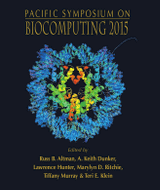
James Diggans1, Su Yeon Kim1, Zhanzhi Hu1, Daniel Pankratz1, Mei Wong1, Jessica Reynolds1, Ed Tom1, Moraima Pagan1, Robert Monroe1, Juan Rosai2, Virginia A. Livolsi3, Richard B. Lanman1, Richard T. Kloos1, P. Sean Walsh1, Giulia C. Kennedy1
1Veracyte, Inc.
2Centro Diagnostico Italiano
3Department of Pathology, Perelman School of Medicine, University of Pennsylvania
Email: giulia@veracyte.com
Pacific Symposium on Biocomputing 20:371-382(2015)
The promise of personalized medicine will require rigorously validated molecular diagnostics developed on minimally invasive, clinically relevant samples. Measurement of DNA mutations is increasingly common in clinical settings but only higher-prevalence mutations are cost- effective. Patients with rare variants are at best ignored or, at worst, misdiagnosed. Mutations result in downstream impacts on transcription, offering the possibility of broader diagnosis for patients with rare variants causing similar downstream changes. Use of such signatures in clinical settings is rare as these algorithms are difficult to validate for commercial use. Validation on a test set (against a clinical gold standard) is necessary but not sufficient: accuracy must be maintained amidst interfering substances, across reagent lots and across operators. Here we report the development, clinical validation, and diagnostic accuracy of a pre-operative molecular test (Afirma BRAF) to identify BRAF V600E mutations using mRNA expression in thyroid fine needle aspirate biopsies (FNABs). FNABs were obtained prospectively from 716 nodules and more than 3,000 features measured using microarrays. BRAF V600E labels for training (n=181) and independent test (n=535) sets were established using a sensitive quantitative PCR (qPCR) assay. The resulting 128-gene linear support vector machine was compared to qPCR in the independent test set. Clinical sensitivity and specificity for malignancy were evaluated in a subset of test set samples (n=213) with expert-derived histopathology. We observed high positive- (PPA, 90.4%) and negative (NPA, 99.0%) percent agreement with qPCR on the test set. Clinical sensitivity for malignancy was 43.8% (consistent with published prevalence of BRAF V600E in this neoplasm) and specificity was 100%, identical to qPCR on the same samples. Classification was accurate in up to 60% blood. A double-mutant still resulting in the V600E amino acid change was negative by qPCR but correctly positive by Afirma BRAF. Non-diagnostic rates were lower (7.6%) for Afirma BRAF than for qPCR (24.5%), a further advantage of using RNA in small sample biopsies. Afirma BRAF accurately determined the presence or absence of the BRAF V600E DNA mutation in FNABs, a collection method directly relevant to solid tumor assessment, with performance equal to that of an established, highly sensitive DNA-based assay and with a lower non- diagnostic rate. This is the first such test in thyroid cancer to undergo sufficient analytical and clinical validation for real-world use in a personalized medicine context to frame individual patient risk and inform surgical choice.